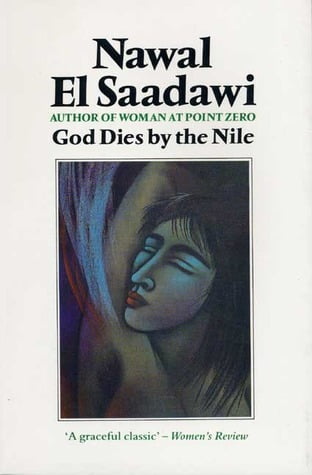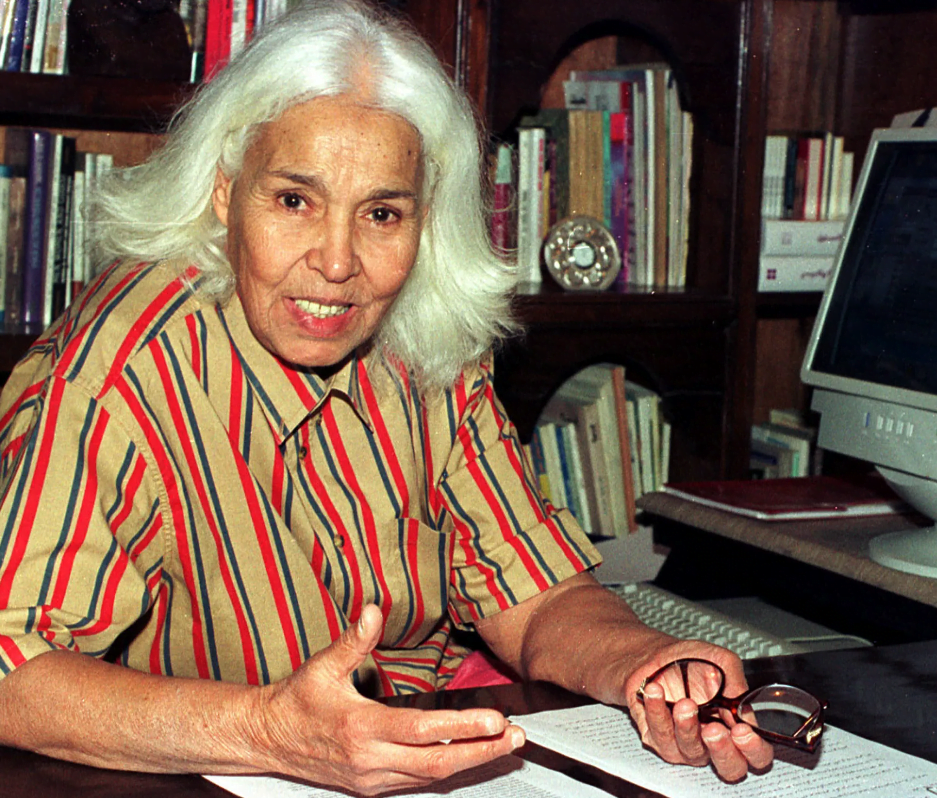Nawal El Saadawi, an Egyptian feminist writer, activist, and physician, made a significant impact through her unwavering support for women’s rights and her thought-provoking literary works that fearlessly confronted societal norms and injustices. The author’s birthplace was Kafr Tahla, Egypt, and she was born on October 27, 1931. She departed from this world on March 21, 2021, in Cairo.
Saadawi’s writing delves into the complex and pressing topics of female genital mutilation, gender equality, and the oppression faced by women in Arab societies. She was a notable figure in the feminist movement, often referred to as “the Simone de Beauvoir of the Arab world” for being a leading voice in the Arab world. Her work and career were focused on advocating for women’s political and sexual rights. Saadawi’s life was marked by constant struggles – imprisonment, threats, and legal battles – all stemming from her unwavering commitment to speaking out against societal injustices.
Exploring societal injustices and women’s rights through words
Nawal El Saadawi has written several highly acclaimed books that have garnered widespread recognition for their impactful messages, unwavering support for women’s rights, and thought-provoking examination of societal inequalities. Woman at Point Zero is an incredibly impactful novel that delves into the life of Firdaus, a woman who tragically ends up on death row in an Egyptian prison.

God Dies by the Nile is a remarkable piece of literature that delves into the social issues prevalent in Egyptian society. The Hidden Face of Eve: Women in the Arab World is a highly impactful book that explores the lives of women in the Arab world, providing valuable insights into the challenges they face due to gender disparities and cultural expectations.
The Fall of the Imam is a captivating novel that delves into the intricate world of power, politics, and societal dynamics. Through its compelling narrative, it skillfully explores these themes, offering readers a thought-provoking and engaging experience. Zeina is a captivating work that delves into social issues and personal struggles, showcasing Saadawi’s distinct voice and storytelling style.
Chronicling her journey towards empowerment
A Daughter of Isis: The Early Life of Nawal El Saadawi by Nawal El Saadawi provides a deep understanding of the experiences and challenges faced by this extraordinary Egyptian feminist and activist. The autobiography explores Saadawi’s formative years in Egypt, chronicling her transformation from a young child to a young adult. It emphasises her unwavering resistance against societal injustices and dedication to achieving gender equality.

Saadawi’s storytelling exudes a sense of empowerment and agency, beautifully illustrated through her vivid connection to the powerful Goddess figure, Isis. This connection serves as a symbol of strength and resistance as Saadawi embarks on her journey towards personal autonomy.
The book is written in the form of a thought-provoking memoir which is deeply influenced by her unique perspective, shaped by her experiences as an Egyptian woman, feminist, and activist. She presents a multifaceted examination of various societal factors, including gender, class, and culture, within the intricate tapestry of Egypt’s social and political milieu, providing a nuanced examination of power dynamics and oppression within society.
The book skillfully intertwines themes of social constraints, gender roles, and the influence of patriarchal structures on Egyptian society, offering a powerful reflection on Saadawi’s encounters with a society characterised by strict hierarchies and oppressive customs. She delves into her struggles and provides valuable insights into the complex issues of race, displacement, and colonialism. Her narrative offers a thought-provoking examination of how gender, sexuality, class, and race intersect to shape her unique perspective.
A Daughter of Isis is a powerful testament to Saadawi’s remarkable resilience, unwavering courage, and relentless dedication to challenging societal norms.
An intersectional lens
The writing in A Daughter of Isis is greatly shaped by Nawal El Saadawi’s deep understanding of intersectionality. The book is written in the form of a thought-provoking memoir which is deeply influenced by her unique perspective, shaped by her experiences as an Egyptian woman, feminist, and activist. She presents a multifaceted examination of various societal factors, including gender, class, and culture, within the intricate tapestry of Egypt’s social and political milieu, providing a nuanced examination of power dynamics and oppression within society. Her storytelling skillfully intertwines these different aspects, creating a rich and multifaceted tapestry. Her writing demonstrates a profound grasp of the intricate ways in which different types of prejudice overlap and intensify, impacting individuals in distinct ways depending on their specific social circumstances.

Saadawi explores her upbringing within a society characterised by male dominance, while simultaneously examining the wider structural disparities that affect the lives of women. Through the seamless integration of her personal experiences and societal concerns, the author sheds light on the intricate connections between gender-based subjugation and various other dimensions of marginalisation, including socioeconomic inequalities and cultural norms. Her work serves as a profound exploration of the intricate nature of individual identity and its profound influence on one’s lived experiences. Through her incisive critique, she compels readers to confront the complex web of oppressive forces that influence and mould individuals’ experiences.
Her compelling narrative illuminates the intricate dynamics that influence the experiences of women, exposing their adeptness in manoeuvring through various forms of prejudice and marginalisation. An intriguing feature of the book lies in Saadawi’s unreserved depiction of her evolution towards a heightened awareness of feminist principles.
The author provides a thoughtful analysis of her early experiences within a conservative Egyptian household, delving into the complexities and obstacles she encountered while defying conventional gender norms and societal expectations. She weaves personal anecdotes with astute analysis, offering readers a profound comprehension of the intricate relationship between gender and power.
Resilience unveiled
The book provides significant insights into the wider socio-political landscape of Egypt, specifically during the mid-20th century. Her portrayal of the social upheavals and political struggles that influenced her early life provides readers with a profound insight into the intricate dynamics of Egyptian society from the perspective of a female.
A Daughter of Isis presents a stimulating analysis of intersectionality, urging readers to engage in a discerning examination of the intricate dynamics between gender, class, and culture.
Saadawi’s memoir exhibits undeniable potency, yet it is not devoid of certain constraints. Some readers may perceive the author’s viewpoint as somewhat limited, specifically due to its concentration on her encounters as an educated, middle-class Egyptian woman.
Saadawi demonstrates an understanding of the complex nature of oppression, recognising how different forms of discrimination intersect. However, it is worth noting that there are instances in which she falls short of fully delving into the intricacies of certain identities, such as class and religion.
A Daughter of Isis presents a stimulating analysis of intersectionality, urging readers to engage in a discerning examination of the intricate dynamics between gender, class, and culture. It functions as a compelling amalgamation of personal recollections and a comprehensive analysis of the ongoing battle for gender parity in Egypt and other regions.
About the author(s)
Insha Qayoom Shah is a Research Scholar from the Department of English, University of Kashmir pursuing her PhD on Female Revisionary Mythmaking: A Study of Select Novels. The areas of her interest include Feminism, Mythology and the Revisionary literature. She has presented four papers in different national and international conferences. She has also contributed chapters in three books dealing with the feminism and gender studies.





